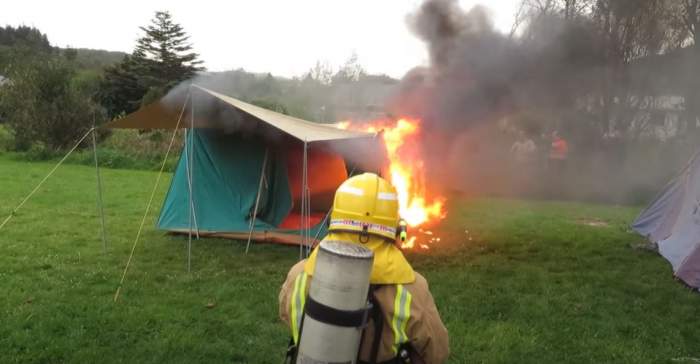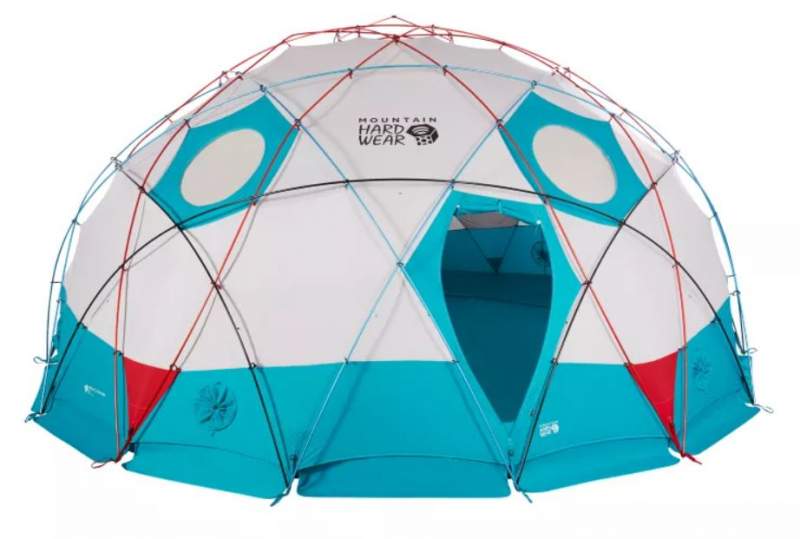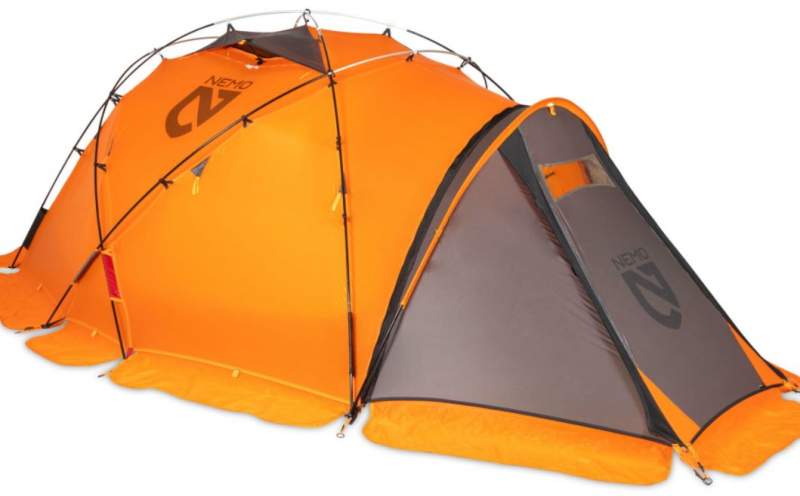This question I received recently in a comment, so I gave a short answer there, and here is more. So what is a fire retardant tent made of? Keep reading, you will find the answer.

Did you know that it is far from easy to burn down a modern tent? If you do not believe it, it is best that you see a video in my text on how to cook in a tent.
Though, in the same text, you will see yet another example of an old-fashioned tent that was destroyed by fire very fast. The picture above is from that same video. So you realize this has something to do with fire retardant materials used in the construction of modern tents.
The point is that you can indeed cook in modern tents and you can heat them, read more here. Using fire in the tent is not really a big issue. But there are some other potential hazards related to this, and one of them deals with the flame retardance substances used in a tent’s construction.
The question raised in a comment mentioned above you can see in my other text, it is in the list of comments. So let’s see what the issue of flame retardance really is.
Flammability standard CPAI-84
Camping tents are expected to meet the CPAI-84 standards. From what I know, this is a voluntary specification for most countries.
But there are exceptions, some of the U.S. states have their local laws that require camping tents to pass the CPAI-84 flammability standard. These include at least the following: California, New York, New Jersey, Louisiana, Massachusetts, Michigan, and Minnesota, there may be more.
The abbreviation CPAI comes from the words Canvas Products Association International, but nowadays this applies to all types of tents’ materials. This is why you will see also the abbreviation IFAI that comes from Industrial Fabrics Association International.
Note that this is not about fire-proof materials, this is only about fire resistance. In their testing, a flame is applied to the material for several seconds (it appears 4 seconds or so), and the damage caused by the flame should be smaller in size than 255 mm. This should not be mixed with NFPA 701 Certification which is something very different.
In any case, this CPAI standard is introduced for safety reasons, but it may result in health risks. So the natural question would be to see which of the two is more dangerous, fire or the chemicals used to prevent such a fire.
So what is a fire retardant or flame retardant tent material?
There is nothing special about the tent fabric, this is about the usual materials, synthetic (polyester, nylon, polyethylene) and canvas (cotton or polycotton). This is about some fire retardant applications. These are chemicals, and they may be harmful because they may rub off onto the hands and they can be absorbed into the skin. Or you can inhale them directly through the dust that is in the air.
There was a study on this issue under the title Flame Retardant Applications in Camping Tents and Potential Exposure by A. S. Keller et al., which you can download here. Here are some of the conclusions:
- They analyzed tent fabric samples that contained flame retardant additives. Those were chemicals like tris(1,3-dichloroisopropyl) phosphate (TDCPP), decabromodiphenyl ether (BDE-209), triphenyl phosphate, and tetrabromobisphenol.
- Flame retardant concentrations were discovered to be as high as 37.5 mg/g (3.8% by weight) in the tent fabric samples. The TDCPP and BDE-209 were the most frequently detected in these samples. So you realize there is lots of this material on the surface of the fabric.
- They observed a significant association between TDCPP levels in tent wipes and those in paired hand wipes.
- This suggests that human contact with the tent fabric material leads to the transfer of the flame retardant to the skin surface and to human exposure in general.
- Dermal absorption of some of these chemicals may be low.
- Inadvertent ingestion of these chemicals could occur through hand-to-mouth transfer activities. I wish to point out this in particular if this is camping with kids.
- Inhalation could be a route of exposure for individuals sleeping in tents, and this holds in particular for organophosphate flame retardants such as TDCPP. Note also that TDCPP is considered a probable human carcinogen and is listed on California’s Proposition 65 list of carcinogenic and reproductive chemicals. It has a disruptive role in immune response and thyroid hormone signaling,
So this is why you have the mentioned California Proposition 65 which makes it mandatory for manufacturers to inform you about potential health hazards. They update the list regularly, and you can see it here. If you want to have it saved in your computer, here it is. It contains some of the materials used as flame retardants.
Here is a partial list of chemicals that you can expect to have in the tents around:
- tris(1,3-dichloro-2-propyl)phosphate (TDCIPP)
- triphenyl phosphate (TPHP)
- tris(2-chloroethyl) phosphate (TCEP)
- 3,5,3’,5’- tetrabromobisphenol A (TBBPA)
- tris (2-chloroethyl) phosphate (TCEP)
- 1,2,5,6,9,10- hexabromocyclododecane (HBCD)
- 2-ethylhexyl-2,3,4,5-tetrabromobenzoate (TBB)
- bis(2- ethylhexyl)-tetrabromophthalate (TBPH)
- decabromodiphenyl ether (DecaBDE)
- pentabromodiphenyl ether (PentaBDE)
I am a theoretical physicist and not a chemist, so cannot say much about these materials, but they do not look great to me.
Now, what to do when you know all this? There are at least two very different things:
i) Avoid using tents with flame retardants
Some people ask sellers about this, I have seen this many times. Though, my guess is that they ask mainly because they want to have a “safe” tent and want to have flame-retardant materials. In any case, there are tents without fire retardants.
From what I have read, it seems that tents made of Dyneema Fiber Fabric, also known as Cuben Fiber, are free of flame-retardant materials. But I may be wrong, please correct me if you know more.
Also, Fjällräven tents seem to be free of such chemicals. On their site, I read about one of their tents that it is “made entirely without PVC plastic and toxic flame retardants, and its impregnation is fluorocarbon free.” After more reading on their site, it is clear that they switched to fluorocarbon-free materials in 2012, you can read more here.
Also, the Mountain Hardwear Space Station Tent (shown in the picture) seems to be safe. They write “Free of flame-retardant chemicals, this tent may not adhere to CPAI-84”. So you realize what the issue is, it is not safe against fire, but it is safe with respect to chemicals. The same is with other new tents of this brand, see this Mountain Hardwear Trango 4 Tent.

However, I have not seen this statement with their Mountain Hardwear Stronghold 10 Tent. It seems that this is because of their relatively new shift in the practice of making tents introduced only several years ago.
There are tents by Nemo that are also without fire retardants, this Nemo Chogori Mountaineering 4 Person tent is one example.

ii) If you use tents with flame retardants, try to reduce contacts with the tent fabric as much as possible
Also, wash your hands when you eat. But clearly, it is very unrealistic that you can manage to behave this way. When you camp with kids, this is a mission impossible, you cannot control everything they do.
But what about sleeping pads and other synthetic stuff used in the tent and for camping in general? It seems that there are brands that build such items without flame retardant chemicals. From what I know, this holds at least for some pads of Therm-a-Rest, Exped, and Teton Sports. There may be more, let me know if you know.
You might want to read also my comparison of single wall tent vs double wall tent. It will be great to hear what you think, there is a comment box below. Thank you for reading.
Leave a Reply